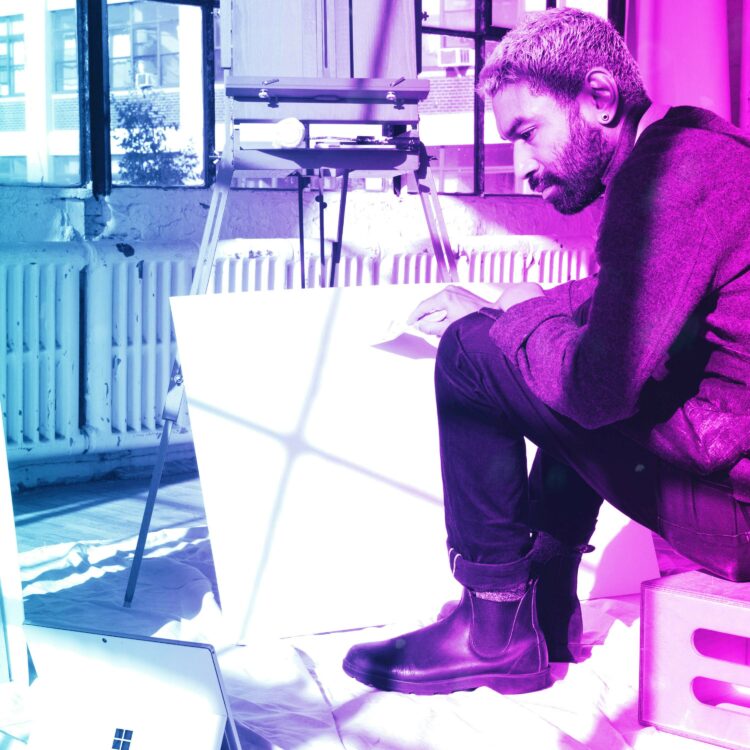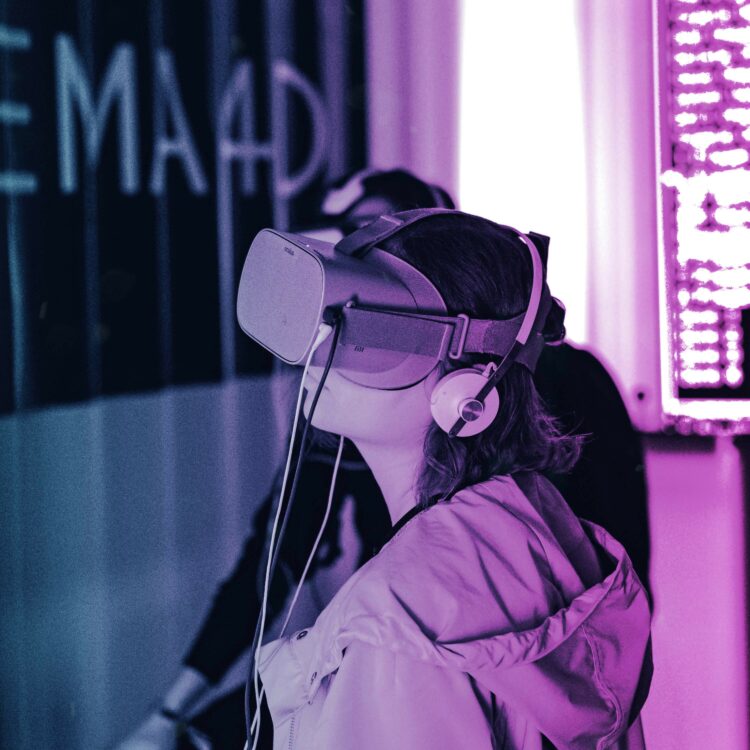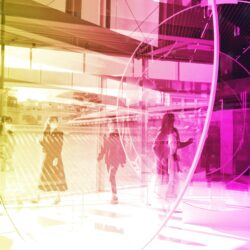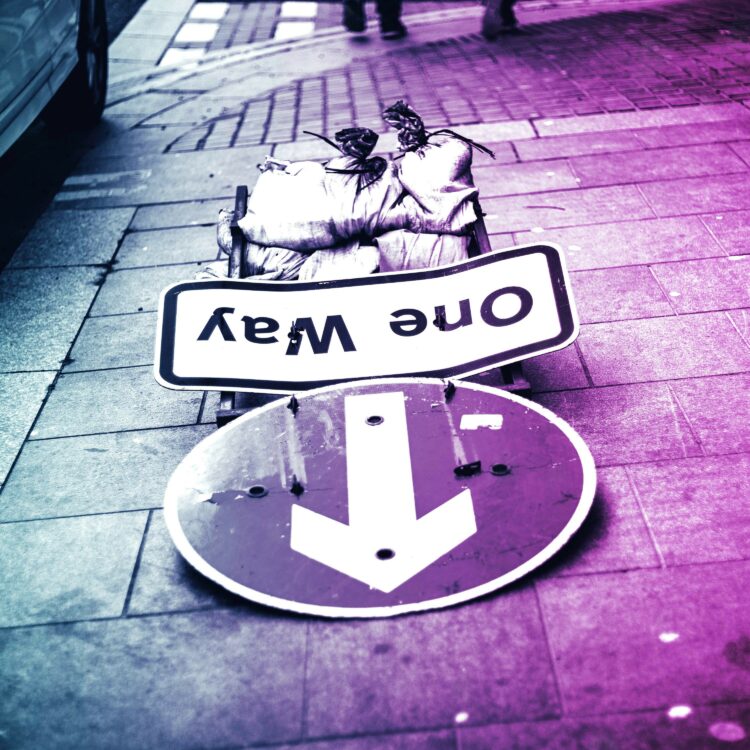
These contributions reflect recent discussions on expanding professionalism in the arts. The narrative scans how some interviewees in the Fast45-project talk about such expansion, how some of the new work opportunities call for new competencies from professionals in the arts and what this could mean for art education. The video is a creative representation of the same topic.
Video credits
Texts:
Kai Lehikoinen & Satu Tuittila,
UNIARTS HELSINKI
Videography and voice-over:
Eeva Siljamäki,
UNIARTS HELSINKI
Pictures, videos, and music:
canva.com
Written by Kai Lehikoinen and Satu Tuittila, Center for Educational Research and Academic Development in the Arts, University of the Arts Helsinki, 2022.
“I think the artists, a lot of artists have very different views and very different ideas on how to create things. And I think that’s the main part. That the most important part about an artist is creativity.”
Denise Bischof is currently studying the master’s program Creative Technologies at Film University Babelsberg KONRAD WOLF in Germany. She was interviewed by the FAST45 Knowledge Alliance on the 7th of April 2021.
In the new millennium, the arts have become a domain of growing diversity, and the narratives that frame professionalism in the arts have become increasingly fluid and deterritorialised (Gielen, 2015). Future professional expansions in the arts will most likely contribute to further diversification of artists’ professional aspirations, mindsets, focuses, ways of working, and partnerships. Despite such diversification, it is fair to agree with Denise Bischof, a software developer and a master’s student in Creative Technologies at the Film University Babelsberg, Potsdam, Germany, who sees creativity as a professional core competence of all artists even if their views on how to make art may differ.
This article uses recent discussions on expanding professionalism in the arts as a springboard to probe the phenomenon. We scan how some interviewees in the Fast45-project talk about such expansion and how some of the new work opportunities call for new competencies from professionals in the arts.
Diverse professional practices in the arts are connected to the notion of professionalism that, according to researchers Helena Gaunt and Heidi Westerlund (2021, xiv), includes “the conduct, aims, values, responsibilities, and ongoing development of a practicing professional.” Drawing from educational theorists David Carr’s work on professionalism and ethics, they claim that professionalism in the arts is concerned “both with competencies and with the enacting of working practices in occupations that are inherently ethical in nature” (ibid.). They see that “professionalism in music, as for other art forms, opens the way to professional status, embracing newer values, ethics, and purposes, but at the same time continuing to champion specialist expertise at the heart of practice” (Gaunt & Westerlund 2021, xv, emphasis in original). Thus, the core of artists’ professional practice still entails skill and ability to work with relevant art media and instruments and artistic creativity in its different forms.
Yet, professionalism in the arts expands and the value of the arts, artistic thinking and creativity is increasingly recognised in new contexts outside the arts field: for example, in health and care, innovation development, organisation development, and youth work (Fancourt & Finn 2019; Heinsius & Lehikoinen 2013; Berthoin Antal 2015; Catterall et al. 2012). It is, therefore, necessary to reconsider not only what the future work of artists, art educators, and artist-researchers may encompass but also how higher arts education prepares them for their prospective careers.
In the Fast45-project, we strive to understand the possible futures of higher arts education in Europe. For that purpose, we interviewed several arts professionals in several European cities. For this article, we qualitatively analysed the interviews to pull out how some interviewees refer to expanding professionalism in the arts. We wanted to find out, how the interviewees perceive such expansion and what they say about additional competencies that professionals in the arts may need beyond the core artistic competencies in the future. What do such competence needs suggest for future higher arts education as the world of work is changing in the arts and elsewhere?
While the exploration of artistic ideas and their materialization with the creative play of imagination will continue to be of primary interest for most artists, even their work and mindsets concerning their professional role are likely to transform in tandem with changes in working life. The world of work is undergoing some of the most radical change since the Industrial Revolution (see, e.g., Dent et al. 2016; Susskind & Susskind 2015; Vogd 2017). Schwab (2016) claims that these changes are driven by the exponential pace of new breakthroughs and their scope of disruption, which is global and includes almost every professional field. Further, the systems impact transforms production, management, and governance modes (ibid.). Liakopoulos, Barry and Schwartz (2013) from the international consulting service Deloitte Development LCC write how a macro shift towards the open talent economy will expand organizations’ talent networks, including:
“‘partnership talent’ (employees who are parts of joint ventures), ’borrowed talent’ (employees who are part of contractors or outsourcing relationships), ’freelance talent’ (independent, individual contractors), and ’open source talent’ (people who don’t work for you at all, but are part of your value chain and services).”
Driven by globalization, technological development, mobile computing, the explosive growth of the education sector, social media, and analytics, this shift “will ultimately rewrite what the term ‘workforce’ actually means” (Ibid.), they argue. Moreover, it is likely to embrace almost every industry globally, calling for both employers’ and employees’ resilience, flexibility, and adaptability.

The changes above are likely to influence the future working conditions of many artists, arts educators, and artist-researchers, particularly when the value and impacts of art on, for example, creativity, learning, health and well-being, environment and sustainability, innovation, the economy, society, and politics become better known in society (see, e.g., Henley, 2016; Belfiore & Bennett, 2008). As part of this transformation, there is also a need to discuss the role of the arts as part of the expanding service sector and business operations (Ministry of Education and Culture, 2019). In the light of these and other changes, it becomes a matter of importance to discuss and reconsider, what professional competencies artists, arts educators, and artist-researchers need to succeed in the future worlds of work.

Gaunt and Westerlund (2021) note how professionalism involves competencies, practical enactments, and ethical concerns of the work that require discipline expertise, responses to societal needs and values, and is also “inherently valuable to society” (Ibid., xiv). While artists often assert artistic autonomy, professional communities more generally tend to align “with a well-developed code of ethics that guides practitioner behaviour and defines the profession’s core values, and processes for disciplining those in breach of these standards” (Ibid.). Seen from this perspective, professional education in the arts needs a strong forward focus, “providing future professionals with relevant education in particular craft skills, and with nurturing their visions for their work as artists in present and future societies” (Gaunt & Westerlund 2021, xiv).
Gaunt and Westerlund (2021) argue for a need to reconsider professionalism in the arts for two reasons: First, rapid societal, institutional, and cultural transformations contribute towards increasing unpredictability and uncontrollability in life, calling for re-envisioned and upgraded societal interactions from higher arts education. Second, professionalism in the arts is not just a matter of getting a job. It is also about keeping abreast of professional developments embracing many fields, particularly related to “critical issues of societal responsibility” (Gaunt & Westerlund 2021, xv).
The growing need to break down silo mentalities (Casciaro et al. 2019), think outside the box, and embody aesthetic and artistic ways of knowing in search for big and small solutions in trans-professional contexts is likely to create new job opportunities for artists.

Some professional arts students show great interest in such intellectual cross-fertilisation. For example, Lauri Grünthal, a music graduate in Finland mentions that:
“There is great demand and need for creative thinking in all sectors of society, whether we are talking about big corporations or boards of directors or primary education or higher education or basic public services, I think art would have a place in all of them.”
Lauri Grünthal, Secretary-General of the Student Union of the University of the Arts Helsinki [ArtSU] and specialist in music education. Lauri Grünthal was interviewed by the FAST45 Knowledge Alliance on the 3d of May 2021.
He appreciates, next to art’s intrinsic value, art’s potential to incite public discussion about unheeded but vital topics and contribute to solving significant societal and environmental problems such as climate catastrophe. He confesses, though, that he has “probably given more thought to the wider ecological trends in society than to megatrends in art” (Lauri Grünthal). He would also like to get engaged with some of the topics that students in economics talk about. Or, as he puts it:
“… bearing in mind that I do represent a Helsinki-based artist bubble, so it is quite easy to see all kinds of signals. But I would say that those who study economics … are doing research or writing their theses from really good perspectives and are bringing in aspects to the debate that I, too, want to see there. So, that gives me hope that perhaps these could become more mainstream phenomena. But perhaps little by little.”
As the need for artistic thinking and creativity outside the arts field grows, “artists will more and more step outside their bubble and share their expertise and artistry” (Lauri Grünthal). That, he suggests, calls for “open-mindedness among artists themselves, too, that art can be utilized” (Ibid.).

Ideas extrinsic to the arts may take time to enter the mainstream art debates. Also, the more orthodox views of art for art’s sake do not necessarily fit with the professional identity and assignments of those artists who work in the new contexts. For example, Flo Kasearu is an Estonian artist whose work amalgamates performative practices, drawing, painting, sculpture, installation, and video. She deals with themes ranging from social topics such as domestic violence and unemployment to questions about patriotism and nationalism (CCA 2021). Kasearu notes how she “want[s] to be active not only in the art context, but also be part of the society, still as an artist, but also as a citizen” (Flo Kasearu). She describes further her professional aspirations as follows:
“I want to collaborate with different real-life institutions or problems or topics. And I think that in my case this is also the role of art that I do, that it would not only be my imagination, but that this imagination and the play would be connected with contemporary life that we live in.”
Flo Kasearu is an artist and co-founder of Naked Island art work production platform. She was interviewed by the FAST45 Knowledge Alliance on the 11th of May 2021.
As Kasearu goes on talking about her experiences as an artist-activist collaborating with a women’s shelter, a non-governmental organisation run by her mother, she highlights both reciprocity and societal relevance that inspire her social engagement through the arts practice:
“… it makes sense to do so … I can help, and it makes sense to collaborate with, for example, the … women’s shelter, so that we both can benefit from that. They need more ways to be talked about and I feel that [domestic violence] … is a very multileyered topic, and I just want to be able to have a dialogue with this [topic], and this is also in society [a] very, very big issue.”
While Kasearu finds inspiration from social themes and her collaboration with the women’s shelter, she also sets limits to her professionalism as an artist-activist:
“I don’t want to be a politician, and I’m not a social worker. So, if I start a project, also, my aim is not to solve some kind of problem, or, my goal is not to find some solutions. But I feel that my role as an artist is to give this abstract [view] and more layers into this topic, things that other fields cannot give.”
Thus, Kasearu prefers to illuminate and elaborate on the complexity of social problems such as domestic violence rather than ascribing solutions to such problems. However, her artistic reflections can help professionals in other fields—social workers and politicians, for example—better grasp some of the complexities concerning domestic violence and, thus, seek more sustainable solutions for such problems.
While Kasearu may not be interested in providing solutions, other artists may choose to work as change agents: facilitators who have “the skill and power to stimulate, facilitate, and coordinate the change effort” (Lunenburg 2010, 1). Such artists can work, for example, in “artistic interventions in organizations,” which Ariane Berthoin Antal defines as initiatives that introduce “bring people, products, and practices from the world of the arts into organizations, with a more or less clearly defined learning orientation” (2014, 177). Such interventions introduce artists with various backgrounds to play a pivotal part with “their aesthetic ways of knowing and doing, of engaging with people, ideas, artifacts and spaces” (Berthoin Antal & Strauß 2013, 8). They can contribute to the organisation and its personnel in numerous ways: from designing inspirational environments to engaging with environmental and social responsibility, or from collaborative ways of working to enabling change (Schiuma 2011).

Artists as change agents can also create bewilderment with their observations by scanning the organization from a new perspective with a fresh pair of eyes, unrestricted by the corporate discourse. Or, as Flo Kasearu notes:
“The thing is that companies would also really want to collaborate with an artist … Artists would maybe see things from a more critical angle and it might not be the way that the company wants to be presented. So, the company needs to be very open minded, interested in having some other view.”
In other words, artists’ critical observations and interpretations can help depict the organization and its practices from new perspectives. Their insights can help the organization de- and reconstruct its company culture, mission, and values. However, to do that purposefully and constructively rather than ad hoc requires a particular orientation and a mindset that differs from more orthodox art-making. That is, artistic interventions in organizations often require a shift ‘from object-centred towards process- and strategy-centred‘ (Daniel Kotsjuba) mindset where artistic and arts-based processes offer means to address challenges and find solutions to problems and needs of the organization. Such shift can be seen in, for example, design thinking. As Daniel Kotsjuba, an Estonian graphic designer notes:
“As a graphic designer what you do is you quite often design objects, like visual identity for an event or a company etc… But you’re actually not designing only an artifact, you are actually influencing the processes, you are trying to verbalize these processes that are incorporated in the event or in the company, and you understand that your work doesn’t stand aside from everything else. It’s sort of native part of everything that the company does, and you’re actually influencing things on a deeper level.”
Daniel Kotsjuba is a graphic designer working as part of the Estonian Public Sector Innovation Team. He was interviewed by the FAST45 Knowledge Alliance on the 23rd of April 2021.
Kotsjuba’s account underscores the designer’s pivotal role as a change agent, defined by Lunenburg (2010, 5) as “anyone who has the skill and power to guide and facilitate the change effort” in an organization.
Thus, there is more to artists working in organization than creating art objects. It is about the artist facilitating collaborative social interaction processes with or integrated into art-making processes that strive to articulate organisational processes and influence them when needed. Such an orientation requires a mindset that differs from the more orthodox, object- or performance-oriented art-making; a new mindset that embraces approaches that are needs-based, user-centred, and co-creative as, for example, in service design thinking (Stickdorn & Schneider 2010). With this new mindset, artists can find a wide range of new contexts where their professionalism can add unique value. With the same beat, some artists find it necessary to set limitations to their work in new contexts, as Kaserau’s comment (see above) about not being a social worker or a politician suggests. Also, ethical concerns regarding expanded professionalism have grown, and some artists might choose not to contribute to marketing or promotional schemes for ideological reasons.
The music graduate we discussed above, notes how art’s transformative possibilities in society are more interesting than recent art trends because “art represents almost something static or constant” (Lauri Grünthal). He also sees that music “as a more abstract form of art” is not standing out “in a good way in that open-mindedness and change, those are not that emblematic of the field” (ibid.). His view suggests an expansion in appreciation with the shift of emphasis from art’s innate value to extra-artistic meanings and significances that relate to art’s potential to socially engage people in action.
The arts as social engagement refers to participatory art forms (Matarasso 2011). They often utilise skills and knowledge from other disciplines (e.g., education, sociology, and social psychology) to create situations of social interaction and artistic experiences (Helguera 2012) to encourage individuals and groups to dialogue and action (Bishop 2012; Kester 2012). Socially engaged arts practices are generally site-specific in a sense that they consider the sites and the participants’ distinctiveness: their history, social conditions, and political contexts (Sachs Olsen 2019). Often, they focus on societal challenges and gears toward transformation with interventions into social relations (Ibid.).

As professionalism in the arts expands to social engagement, the inevitable question about appreciation frames also the future of artists who choose the new mindset and new contexts for their professional practice. How will agents in the arts sector—peers, gatekeepers, and funding bodies, for example—respond to their work and achievements? Or, as Rosa Meriläinen, general secretary of KULTA ry, a Central Organization for Finnish Culture and Arts Associations, puts it:
“… this probably calls for a value discussion, thinking that if an artist does their job as part of some other organisation, let’s say, maritime industry or something, that will that be understood to be equally valuable artistic work as the one performed within conventional art institutions. And if the collective spirit within the field is that this is not equally valuable artistic work, then that work will inevitably remain in its role, which means that the biggest talent with the most potential will stay within the valued, institutional domain. And then those who are not able to find employment in a theatre or orchestra, will then scrape a living from selling themselves to other organisations. And this is not … a path towards growth and does not make sense for anyone … It does not favour anything (artist nor society) if the artistic success is valued by very traditional ways excluding artist work in, for example, health care or businesses.”
Rosa Meriläinen is an artist, politician and Secretary General of the Central Organization for Finnish Culture and Arts Associations, Kulta. Rosa Meriläinen was interviewed by the FAST45 Knowledge Alliance on the 26th of April 2021.
As Darren Henley, the Chief Executive of Arts Council England, notes, “[g]reat art changes people’s lives” (2016, 2), and artists can benefit the world in many ways, for example, by thinking differently, challenging preconceptions, and inciting co-reflection, co-creation, and action. In this article, we have looked at the accounts of selected interviewees in the Fast45-project to probe the future work of artists. More specifically, we have tried to grasp how professionalism in the arts is likely to expand even more towards socially engaged practices, and what does that mean for future professional training of artists.
As the multifaceted value of art becomes better known in society and professionalism in the arts expands in the future, what matters is that institutions of higher arts education keep ahead of the above mentioned and other transformations. In Grünthal’s words, the task of higher arts education is
“…to draw us a picture of what the purpose of art is in this world … and all the areas that it could be utilised. Obviously, art has an absolute value and art as such is important, but more and more we see a role for art in different fields of life, alongside science, to bring solutions to the ecological crisis or to raise onto the agenda issues that we, otherwise, would not talk about, or aspects that we would otherwise overlook.”
Further, he expects an in-depth debate “on what the purpose of higher education in the arts, or artistic research is … [and] what higher education in the arts has to give” (ibid.). In such a debate, it is crucial to embrace diversity, be open to interdisciplinary dialogue, and have the courage to refrain from referring to old principles in new contexts. Indeed, our interviewee fears that in higher arts education, “we sustain many phenomena almost because, well, that’s how it’s always been done” (ibid).

Only by reconsidering the future purpose of higher arts education can we answer the question about “what type of studies should be … included in the studies for all our students … [and] what type of goal competencies or content should be included in all degree programmes” (Lauri Grünthal). Therefore, higher arts education needs “radical initiatives” (ibid.) that go beyond already existing disciplines and educational programmes, for “if all change simply stems from what exists … that does not work” (ibid). Thus, as we imagine and co-design future strategic steps for higher arts education, we may need to translate our principles, reconsider them, and expand them in developing more apt principles that better meet the future needs of art and artists and those of society. Following the words of a Finnish performance artist, curator, and residency director Leena Kela, it is of great importance:
“… that futures thinking should be incorporated in artist education and artistic development and growth, so that it brings in a practice-based aspect and we are oriented towards the future when thinking what our careers could look like.”
Leena Kela is a performance artist and curator in international performance art, PhD candidate at the Academy of Fine Arts at the University of the Arts Helsinki and Executive Director of the Saari Residence run by the Kone Foundation for artists and researchers. The FAST45 Knowledge Alliance interviewed Leena Kela on the 28th of April 2021.
Check out the FAST45 art school futures scenarios!
TELL ME MOREDive into the research
Discussion
No feedback has been added yet
Share a Thought